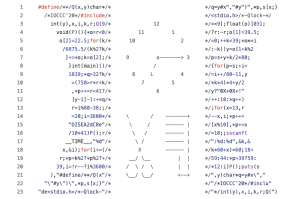Source Code exhibition
Source Code exhibition with UNESCO Software Heritage fundation
Software Heritage, in collaboration with UNESCO and Inria (the French National Institute for Research in Digital Sciences and Technologies), invites authors , historians, artists and museum professionals to contribute their stories of code as a cultural artifact. The exhibition will be part of the celebration of Software Heritage’s 10th anniversary in 2026, and will be on display at UNESCO’s premises in Paris.
Organizers and curators
The project is organized by Software Heritage, a non-profit organization dedicated to collecting and archiving source code.
Since it is a large-scale project with the aim of presenting as many different examples of code as possible in the exhibition, covering as many different temporal and cultural influences as possible that were present during its creation, international experts from various institutions have been invited to curate it, and we are particularly honored that one of them is Boštjan Špetič, who represents the Computer Museum.

Why will this exhibition be different?
This time, instead of being a supporting role in the background, code will become the main star of the exhibition. Source code is more than just its technical role. It intertwines the creator’s intention, reflecting their historical, social and cultural placement, while also expressing personal style, creativity and aesthetic choices.
Your code can be part of the exhibition
We invite you to contribute with the following materials in English or French:
Title of the article
Source code extract (in PNG/JPG, PDF or TXT text file formats), depending on the type of code and purpose – code that is special because it was used for a specific computer/interface, was printed, etc. is best in image formats, where the following guidelines are also important:
Resolution : Ideally 300 DPI or higher, minimum size 2300 × 3500 pixels (or 20 × 30 cm or 8 × 12 inches).
Format : High quality PNG or JPG
Compression : To preserve the original quality, we recommend using solutions for large files instead of compression.
Frames : It is recommended to avoid frames and large offsets from the edges.
Information (source, author, date of creation, license)
Short explanation (up to 300 words) – why the chosen code stands out: historical, technical, aesthetic, social or personal significance
A short biography (up to 100 words) about you and your connection to code
Contribution license: open source (e.g. MIT, Apache 2.0, GPL, CC0) or with permission from the author. Exhibited contributions will be available under the Creative Commons Attribution license ( CC BY 4.0).
Submission date: September 8, 2025 ; selected candidates will be notified by September 30, 2025.
For more information and to submit contributions, please contact sourcecode-exhibit@inria.fr .
What stories does code tell?
Source code as historical testimony
Code is a silent witness to history, so we are looking for code that gave rise to or reflects historical events, from the first hobby computer users onward.
Code as a mirror of society
Source code does not emerge in a bubble, but is embedded in social structures, where norms, temporal components, and cultural biases are present. Therefore, we seek code that reveals the value, political, and unequal aspects of the society in which it was created.
Code as a Work of Art
Creativity and expression can be part of code, which can be a work of art, just like a good book, a piece of music, or a painting. It represents a voice for artistic expression that is unique to the artist.

